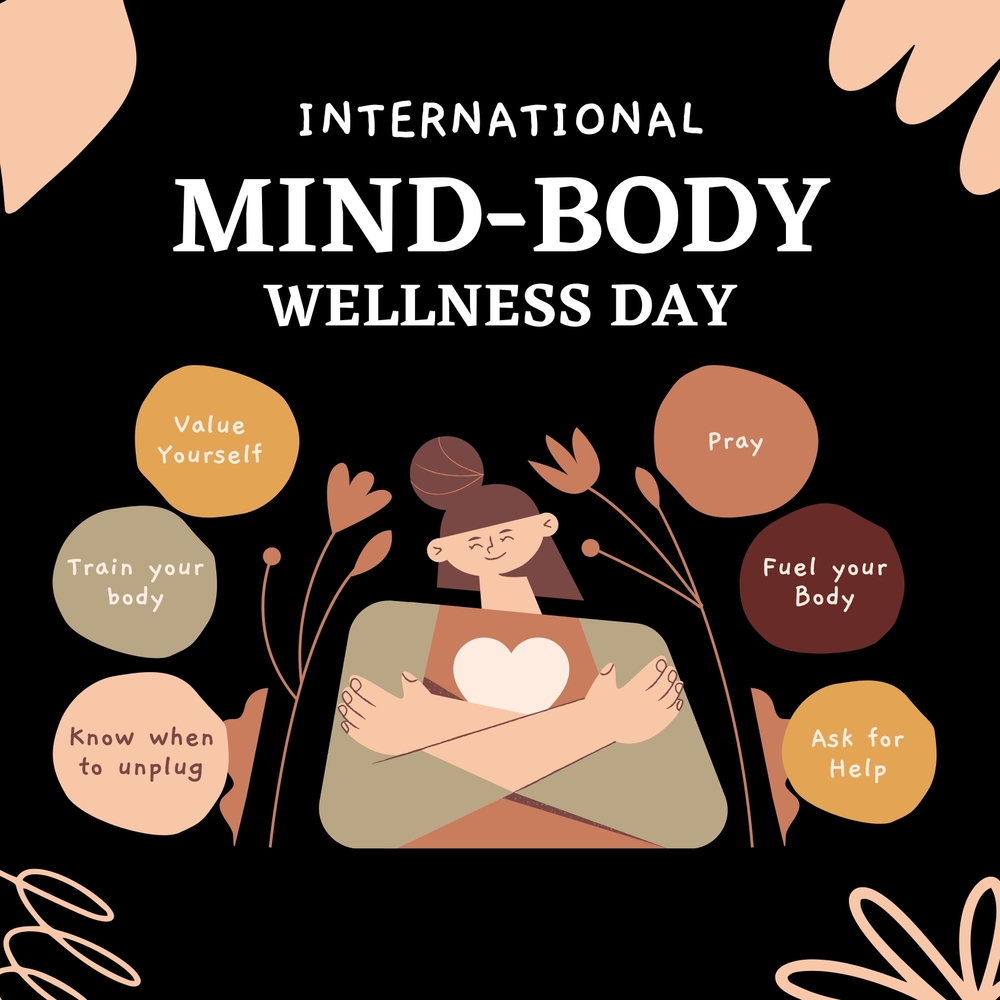
In a world often characterized by fast-paced living, stress, and constant connectivity, achieving a balance between the mind and body has become paramount. Recognizing this need, International Mind-Body Wellness Day has emerged as a powerful global initiative that encourages individuals to prioritize their mental and physical well-being. This day serves as a reminder that true wellness extends beyond mere physical health, encompassing the intricate interplay between our mental and physical states.
The Significance of Mind-Body Wellness
International Mind-Body Wellness Day, celebrated annually on 3rd January 2024, aims to promote holistic health by emphasizing the interconnectedness of mental and physical well-being. This day encourages people to reflect on their lifestyle choices, adopt practices that foster balance and appreciate the profound impact of a harmonious mind-body connection.
Mind-Body Connection
The mind-body connection is a concept that recognizes the intricate relationship between our thoughts, emotions, and physical health. Scientific research has increasingly highlighted the profound influence that mental well-being can have on our overall health. Stress, anxiety, and negative thought patterns can manifest physically, contributing to various health issues. Conversely, a positive mindset and emotional well-being can enhance our physical resilience and vitality.
Here are a few ways for mind-body wellness:
1.Reflect & reconnect: Take time on this day to reflect on your mental and physical well-being. Consider aspects of your life that contribute to stress and identify positive changes that can be made to nurture a healthier balance.
2.Mindful practices: Meditation and deep-breathing exercises become the compass guiding us through the labyrinth of our minds. By embracing these activities, we create a sanctuary within ourselves, a space where stress and tension can dissipate, making room for tranquility and balance [1,2]. Some of the meditation techniques for mind-body wellness are:
a) Mindfulness meditation: It involves the fundamental practice of being fully aware and present in the current moment. The key is to immerse yourself completely in the task at hand, free from distractions or concerns about the future.
How to perform mindfulness meditation:
-Find a quiet and comfortable space to sit or lie down.
-Focus your attention on your breath, observing each inhalation and exhalation.
-If your mind wanders, gently bring your focus back to your breath.
-Practice for a few minutes to start and gradually extend the duration.
b) Body scan meditation: This meditation technique center around inducing relaxation in various body regions, offering an effective means of alleviating tension in areas such as the shoulders. Particularly beneficial for individuals experiencing stress or anxiety, it serves as a valuable practice for those managing chronic pain.
How to perform body scan meditation:
-Begin by bringing awareness to different parts of your body, starting from your toes and moving
up to the top of your head.
-Notice any sensations or areas of tension.
-As you breathe, send relaxation to each part of your body, releasing tension and promoting a sense of ease.
c) Guided visualization: Guided visualization meditation invites a mental journey, as you follow soothing prompts to create vivid, calming images, promoting relaxation and mindfulness in just a few minutes.
How to perform guided visualization meditation:
-Listen to a guided meditation that takes you on a mental journey.
-Visualize a peaceful and serene place, allowing your mind to create a vivid and calming image.
-Engage all your senses in this visualization for a more immersive experience.
d) Mantra meditation: Mantra Meditation involves repeating a chosen word or phrase, fostering a rhythmic and focused state of mind, and enhancing concentration and inner peace.
How to perform mantra meditation:
-Choose a word or phrase that holds significance for you.
-Repeat the mantra either silently or out loud.
-Allow the repetition to create a meditative and calming rhythm.
e) Loving-kindness meditation: This technique encourages cultivating feelings of compassion and goodwill. By extending positive wishes to oneself and others, this practice fosters a sense of love, connection, and emotional well-being.
How to perform loving-kindness meditation:
-Sit comfortably and focus on generating feelings of love and compassion.
-Start by directing these feelings towards yourself, then extend them to loved ones,
acquaintances, and even those you may have challenges with.
-Repeat positive phrases such as “May I/you be happy, may I/you be healthy” in your mind.
f) Zen meditation (Zazen): Embracing stillness and presence, this technique allows practitioners to observe the mind without attachment, promoting inner calm and clarity.
How to perform Zen meditation:
-Sit in a comfortable position with a straight spine.
-Focus your attention on your breath or an aspect of your present experience.
-Allow thoughts to come and go without attachment or judgement.
-Embrace the stillness and cultivate a sense of presence.
Health benefits of meditation
Research has confirmed a myriad of health benefits associated with the practice of meditation. These include stress reduction, decreased anxiety and depression, improved memory, and increased overall efficiency. Physiologically, it reduces blood pressure and cholesterol levels, heart rate, cortisol levels, and enhanced cerebral blood flow, contributing to improved mental well-being and cognitive performance [3].
3. Healthy lifestyle choices: Evaluate your lifestyle choices, including diet, exercise, and sleep patterns. International Mind-Body Wellness Day encourages individuals to make conscious decisions that support both mental and physical health.
4. Connection with nature: Spend time outdoors and reconnect with nature. Fresh air and exposure to natural surroundings have been linked to improved mood and overall well-being.
5. Social support: Foster positive relationships and social connections. Meaningful interactions contribute significantly to emotional well-being and can act as a buffer against stress.
6. Digital detox: Consider taking a break from digital devices. Constant connectivity can contribute to mental fatigue, and stepping away allows for mental rejuvenation.
As we celebrate this day, let us commit to making mindful choices, fostering a harmonious relationship between mind and body, and unlocking the transformative power of holistic health
(The article is written by Monalisa Deka, Senior Health Content Editor)
References
1.Dasanayaka NN, Sirisena ND, Samaranayake N. Impact of Meditation-Based Lifestyle Practices on Mindfulness, Wellbeing, and Plasma Telomerase Levels: A Case-Control Study. Front Psychol. 2022; 13: 846085. Available online: https://www.ncbi.nlm.nih.gov/pmc/articles/PMC8931770/
2.Matko K, Sedlmeier P. What Is Meditation? Proposing an Empirically Derived Classification System. Front Psychol. 2019; 10: 2276. Available online: https://www.ncbi.nlm.nih.gov/pmc/articles/PMC6803504/
3.Sharma H. Meditation: Process and effects. Ayu. 2015; 36(3): 233–237. Available online: https://www.ncbi.nlm.nih.gov/pmc/articles/PMC4895748/
